Prior to 19th century
| History of Texas | ||||||||||||||||||
|---|---|---|---|---|---|---|---|---|---|---|---|---|---|---|---|---|---|---|
 | ||||||||||||||||||
| Timeline | ||||||||||||||||||
| ||||||||||||||||||
- 1519 - Spaniard Alonso Alvarez de Pineda travels to bay on day of religious Feast of Corpus Christi. [1]
The following is a timeline of the history of the city of Corpus Christi, Texas, USA.
| History of Texas | ||||||||||||||||||
|---|---|---|---|---|---|---|---|---|---|---|---|---|---|---|---|---|---|---|
 | ||||||||||||||||||
| Timeline | ||||||||||||||||||
| ||||||||||||||||||
| | This section needs expansion. You can help by adding to it. (April 2021) |
| | This section needs expansion. You can help by adding to it. (May 2017) |
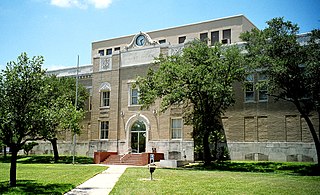
San Patricio County is located in the U.S. state of Texas. As of the 2020 census, its population was 68,755. Its county seat is Sinton. San Patricio County is part of the Corpus Christi metropolitan statistical area.

Nueces County is located in the U.S. state of Texas. As of the 2020 census, the population was 353,178, making it the 16th-most populous county in the state. The county seat is Corpus Christi. The county was formed in 1846 from portions of San Patricio County and organized the following year. It is named for the Nueces River, which marks the county's northwestern boundary with San Patricio County before emptying into its mouth at Nueces Bay north of the port of Corpus Christi. Nueces County is part of the Corpus Christi metropolitan statistical area.

Corpus Christi is a coastal city in the South Texas region of the U.S. state of Texas and the county seat and largest city of Nueces County. Portions of the city also extend into Aransas, Kleberg, and San Patricio counties. It is 130 miles (210 km) southeast of San Antonio and 208 miles (335 km) southwest of Houston. Its political boundaries encompass Nueces Bay and Corpus Christi Bay. Its zoned boundaries include small land parcels or water inlets of three neighboring counties.
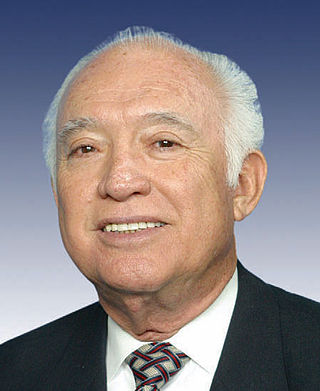
Solomon Porfirio Ortiz is an American former politician who served as the U.S. representative for Texas's 27th congressional district, based in Corpus Christi, serving from 1983 until 2011. He is a member of the Democratic Party. In 2010, Ortiz was narrowly defeated by Republican challenger Blake Farenthold. Ortiz's son, Solomon Ortiz, Jr., is a former state representative.
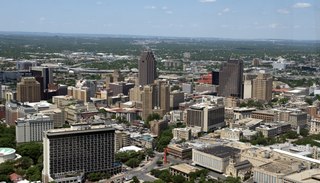
South Texas is a region of the U.S. state of Texas that lies roughly south of—and includes—San Antonio. The southern and western boundary is the Rio Grande, and to the east it is the Gulf of Mexico. The population of this region is about 4.96 million according to the 2017 census estimates. The southern portion of this region is often referred to as the Rio Grande Valley. The eastern portion along the Gulf of Mexico is also referred to as the Coastal Bend.

The Nueces Hotel in Corpus Christi, Texas, was a luxury hotel that also served the city as a center of social and political life during the early 20th century and was for years the largest building in Texas south of San Antonio.
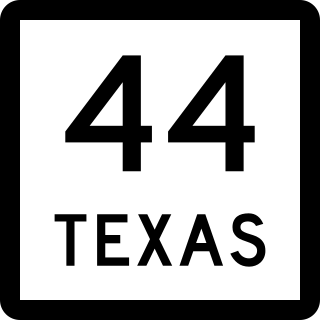
State Highway 44 (SH 44) is a Texas state highway that runs from west of Encinal to Corpus Christi, Texas. This highway is also known as the Cesar Chavez Memorial Highway outside the city limits of Robstown, Banquete, Agua Dulce, Alice, and Corpus Christi in Nueces and Jim Hogg counties.

Corpus Christi Bay is a scenic semi-tropical bay on the Texas coast found in San Patricio and Nueces counties, next to the major city of Corpus Christi. It is separated from the Gulf of Mexico by Mustang Island, and is fed by the Nueces River and Oso Creek from its western and southern extensions, Nueces Bay and Oso Bay. The bay is located approximately 136 miles (219 km) south of San Antonio, and 179 miles (288 km) southwest of Houston.
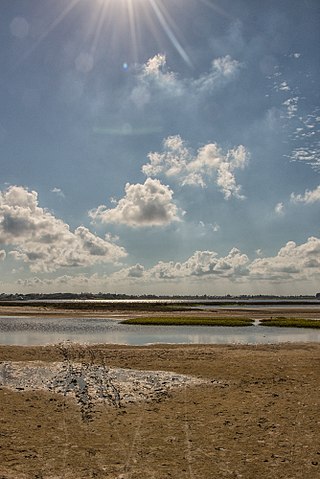
Mustang Island State Park is a state park located south of the city of Port Aransas, Texas, United States on the coast of the Gulf of Mexico that covers 3,954 acres (1,600 ha) and has a 5-mile (8.0 km) beachfront. The land was acquired from private owners in 1972 and opened to the public in 1979. The island takes its name from wild mustangs that roamed the island which eventually succumbed to ranching in the late 1800s.
Old Bayview Cemetery is a cemetery located on a small hill in downtown Corpus Christi, Texas on Ramirez St. at Padre St., bordered by the I-37 access road. It is the oldest federal military cemetery in Texas. Owned by the City of Corpus Christi, it presently comprises three and a half acres as a Historic Texas Cemetery and a State Archaeological Landmark of the Texas Historical Commission. The cemetery was listed on the National Register of Historic Places in 2020.
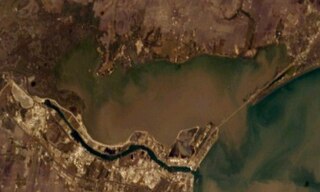
Nueces Bay is a northwestern extension of Corpus Christi Bay in the San Patricio and Nueces Counties of Texas. The bay is fed by the Nueces River, forming a natural estuary, which renders it ecologically and economically vital to the surrounding area. It serves as a habitat for the propagation of fish and shellfish, which sustain diverse species of birds and other wildlife. The bay is threatened by pollution from the heavy industry on its southern shore, which prevents oyster farming. Petrochemical production and oil are important to the surrounding economies of the major settlements of Corpus Christi and Portland, found on the eastern shore and connected by the Nueces Bay Causeway at the bay's confluence with Corpus Christi Bay.
Calallen is a former town that existed until the 1960s. Today, Calallen is an outlying portion of the larger city of Corpus Christi. It is located in Nueces County, in the Coastal Bend region of Texas. It is bound to the north by the Nueces River, which also marks the boundary between Nueces County and San Patricio County.

Corpus Christi is a coastal city in the South Texas region of the U.S. state of Texas. The county seat of Nueces County, it also extends into Aransas, Kleberg, and San Patricio counties. The population was 277,454 at the 2000 census; in 2006 the U.S. Census Bureau estimated the city's population at 285,175, making it the eighth-largest city in the state. It is the principal city of the three-county Corpus Christi Metropolitan Statistical Area as well as the larger Corpus Christi-Kingsville Combined Statistical Area. The translation from Latin of the city's name is Body of Christ, given to the settlement by the Spanish, in honor of the Blessed Sacrament (Eucharist). The city has been nicknamed The Sparkling City by the Sea, or "Corpitos" particularly in literature promoting tourism.
The Port of Port Lavaca – Point Comfort, or simply the Port of Port Lavaca, is a seaport along the shores of Matagorda Bay, Texas. It includes terminals at both Port Lavaca and Point Comfort, Texas. These terminals are connected to the Gulf of Mexico through the Matagorda Ship Channel and by rail via the Point Comfort and Northern Railway which connects to the Union Pacific Railroad.

Henry Lawrence Kinney was an American politician, military officer, and later filibuster known for founding what became the city of Corpus Christi, Texas. Born in Pennsylvania, Kinney moved to Texas in 1838 and settled near present-day Brownsville. He served in both houses of the Texas Legislature. He was killed in a gunfight in Mexico in 1862. Kinney County, Texas is named for him.

Randolph Blake Farenthold is an American politician and lobbyist. A member of the Republican Party, Farenthold co-hosted a conservative talk-radio program before beginning a career in politics. Farenthold served as the U.S. representative for Texas's 27th congressional district from 2011 until his resignation in April 2018 in the wake of reports he used public funds to settle a sexual harassment lawsuit and had created an intensely hostile work environment for women in his congressional office. Upon resigning, Farenthold pledged to reimburse the US$84,000 in public money that he used to settle the lawsuit. He later reneged on his pledge to repay.
The Port of Corpus Christi is the largest port in the United States in total revenue tonnage, third largest in total waterway tonnage, and the largest crude oil export gateway in the nation. The Port of Corpus Christi is located on Corpus Christi Bay in the western Gulf of Mexico, with a 36-mile channel that is being widened and deepened to 54 feet MLLW from its current depth of 45 feet.

Rose Meza Harrison is a Democratic politician and Democratic nominee for U.S. Representative in the 27th Congressional District of Texas.
The following is a timeline of the history of the city of Laredo, Texas, USA.
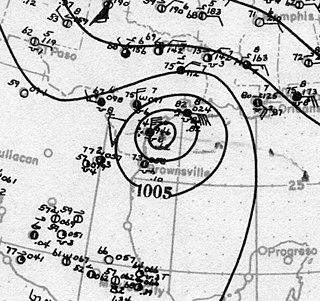
The effects of the 1919 Florida Keys hurricane in Texas were the deadliest of any tropical cyclone in the Texas Coastal Bend, killing at least 284 people. The hurricane produced a widespread swath of devastation across the region, exacerbated by the large extent of its winds. The city of Corpus Christi bore the brunt of the hurricane's impacts, contributing to the largest portion of the damage toll in Texas; nearly all of the confirmed fatalities were residents of the city. The storm originated from the Leeward Islands early in September 1919 and took a generally west-northwestward course, devastating the Florida Keys en route to the Gulf of Mexico. On the afternoon of September 14, the center of the hurricane made landfall upon the Texas coast at Baffin Bay. The storm's winds were estimated at 115 mph (185 km/h) at landfall, making it a Category 3 hurricane on the Saffir–Simpson hurricane wind scale. After slowly moving ashore, it weakened and straddled the Rio Grande before dissipating on September 16 over West Texas.
{{citation}}: CS1 maint: ref duplicates default (link){{citation}}: CS1 maint: location missing publisher (link)